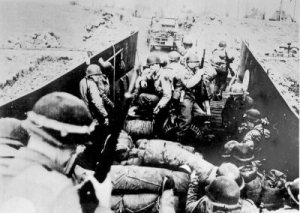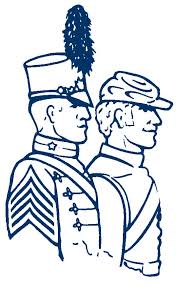Caswell Marbury Higgs, Class of 1944
Caswell M. Higgs was born in Atlanta, Georgia on October 15, 1921 to Mary Claire Marbury Higgs and James Allen Higgs, Jr. He entered The Citadel in August of 1940 as a freshman with the Class of 1944 and was assigned to Cadet Company I. His sophomore year, he was a Cadet Corporal in Company K and became a member of the school’s Calliopean Literary Society and Sons of the American Revolution. [1] [2] At the end of the 1941-42 academic year, Caswell enlisted in the U.S. Army on May 29, 1942 at Charleston, South Carolina. He became an infantry officer and was sent overseas to Europe. [3]

CASWELL MARBURY HIGGS, Class of 1944.
October 15, 1921 – March 28, 1945 [4]
In Europe, Second Lieutenant Higgs was assigned to Company H, 2nd Battalion, 317th Infantry Regiment, 80th Infantry Division. He led a machinegun platoon of the battalion’s heavy weapons company. The 80th, nicknamed the “Blue Ridge Division”, sailed from America aboard the SS Queen Mary and arrived in Scotland on July 7, 1944. After several weeks of training in England, the division crossed the channel and landed at Utah Beach on August 2, 1944. Their baptism of fire came at the LeMans bridgehead on August 8th. [5]

80th Crosses the Rhine at Mainz, Germany [6]
Seven months later, on March 28, 1945, 2Lt. Higgs was killed in action after successfully leading his platoon across the Rhine River and establishing a beachhead for his battalion. That day, Company H suffered twelve casualties in the action: 3 killed, 7 wounded, and 2 missing. [7]
“28 March 1945: Enemy resisted our crossing of the RHINE River by placing heavy artillery direct fire weapons, AA, mortar, and small arms fire on our bridge sites, as well as on the city of MAINZ. After our troops were firmly established on east bank of the RHINE, the enemy infiltrated small groups out of the sector.
2nd Bn seized bridgehead across RHINE R in vicinity MAINZ, meeting determined enemy resistance. Co G repulsed two enemy counterattacks South of KASTEL; Co E repulsed enemy counterattack consisting of undetermined number of infantry and tanks in vicinity of KASTEL. 1st Bn crossed RHINE R 0700A, and attacked to the North. 3rd Bn crossed RHINE R, attacked to the North and seized BIERSTAD. 317th (Reinf) seized the following: KASTEL, WIESBADEN, BIERSTADT, BIERBRICH, KOSTHEIM, ERBENHEIM; also an airplane factory, landing field, six enemy aircraft, an ordnance repair depot, numerous enemy field pieces and 20mm AA guns, a champagne factory with 4,000 cases of champagne and a German military hospital. Approximately 900 PWs were captured during the day. Regtl CP moved to BIERBRICH.” [8]

2Lt. Caswell M. Higgs was posthumously awarded the Silver Star for his actions that day. The citation reads:
“The President of the United States of America, authorized by Act of Congress July 9, 1918, takes pride in presenting the Silver Star (Posthumously) to Second Lieutenant (Infantry) Caswell M. Higgs (ASN: 0-1057101), United States Army, for gallantry in action as a member of Company H, 317th Infantry Regiment, 80th Infantry Division, in action against the enemy on 28 March 1945. While leading his machine gun platoon during a night assault crossing of the Rhine River, he was wounded in the shoulder by enemy machine gun fire. Refusing medical aid, he ordered his assault boat to proceed to the enemy-held bank of the river where he personally led his men in capturing two enemy gun emplacements. Lieutenant Higgs then led his men farther into the enemy lines and secured a small beachhead, which allowed the succeeding assault troops to land with comparative safety. He was again wounded, mortally, while reorganizing his platoon. Lieutenant Higgs’ heroic actions were an inspiration to his men.” [9]
Following the war, 2Lt. Higgs body was repatriated to the United States for reburial. According to U.S. Army records, his body was returned to Georgia, cemetery not indicated, per the wishes of his next of kin. [10]
Lt. Higgs was one of three Citadel Men killed in action while serving with the 80th Infantry Division. Captain MAXWELL FARMER PARROTT, Class of 1937, CO of HQ Battery, 633rd AAA AW Battalion, was killed in action on December 4, 1944 at St. Avold, France when the house in which he was billeted was blown up by a time-bomb left by the retreating Germans. Capt. Parrott now rests in peace at Greenlawn Memorial Gardens, Spartanburg, South Carolina. Private First Class WILSON ADELBERT WENDT, Class of 1945, an infantryman with Company E, 2nd Battalion, 317th Infantry Regiment, was killed in action in Germany on April 11, 1945. PFC Wendt now rests in peace at Netherlands American Cemetery.
/RL
Acknowledgements:
Photos courtesy of The Citadel Archives and Museum, Charleston, South Carolina.
Mr. Andy Adkins and the 80th Infantry Division website
Footnotes:
[1] Ancestry.com
[2] 1941 Sphinx and 1942 Sphinx
[3] Fold3.com
[4] Photo source: 1942 Sphinx, The Annual of the South Carolina Corps of Cadets, Charleston, South Carolina.
[5] History of the 80th Division
[6] From the private collection of A.Z. Adkins, Jr. (317th, H Company)
[7] Company H Morning Reports March 1945
[8] 317th Regimental History March 1945
[9] General Orders: Department of the Army, General Orders No. 28 (June 16, 1949)
[10] Ancestry.com

